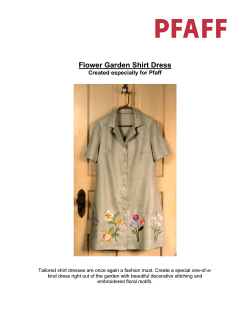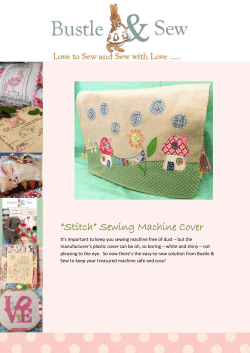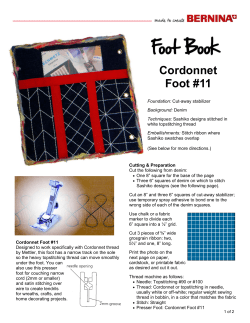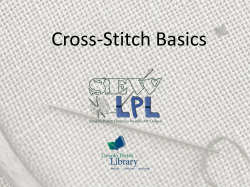
SINGER JOY Wall Decor
SINGER® JOY Wall Decor This beautiful piece will surely brighten up your holiday décor. It features machine decorative stitching, machine appliqué and free-motion work. Shopping List: ¾ yard green silk dupioni Cut one 15” x 39” (backing) Cut one 2” x 13” (rod pocket) Cut one 8” x 8” square (for letter “O”) Cut three 2” x 45” strips (border) ¼ yard burgundy silk dupioni Cut three 1¼” x 45” strips (border) Cut two 8” x 8” square (for letters “J” & “Y”) ⅓ yard gold silk dupioni Cut one 12” x 34” (center) Dark green felt 8” x 8” square Low-loft cotton batting (15” x 40”) Tassel Gold seed beads Six to eight red ½” buttons Various ribbons and trims for the embellishing the letter “J” Double-sided fusible web Rayon embroidery threads: gold, green and burgundy All-purpose thread (green) Bobbinfil Monofilament thread (smoke color) Tear-away stabilizer Edge joining foot Quarter-inch foot Darning/embroidery foot Rotary cutter, mat & ruler Hand sewing needle Preparing the Fabric: 1. Place a piece of tear-away stabilizer under one of the burgundy 8” squares of silk. Mark a diagonal line across the square for stitching direction. a. Note: Use Bobbinfil in the bobbin when sewing with the satin and decorative stitches. Using the assorted thread colors and stitches, apply the trims to the fabric. Alternate the trims with rows of decorative stitching until the fabric is filled. b. Note: The edge-joining foot is an excellent tool for butting two pieces of trim together, side by side, and sewing simultaneously to the fabric using a zig-zag stitch. Carefully remove as much of the stabilizer as possible. 2. Using a pencil, trace the letters J, O, Y (patterns for letters included in last three pages of these instructions) onto the paper side of the double-sided fusible web. Note: You will need to adjust the size of the templates provided to fit your fabric. The letters must be flipped over because the fusible web will then be pressed onto the back side of the fabric. 3. Follow the manufacturer’s instructions for applying the web to the fabrics. The “J” should be applied to the wrong side of the burgundy silk that was embellished with the trims and the decorative stitches; the “Y” to the remaining burgundy silk square; and the “O” to the green silk. After the webbing has been applied to the fabrics, cut the letters out. Carefully remove the paper. 4. Mark a line vertically down the center of the 12” x 34” gold silk. Position the letters down the center of the fabric. Start by placing the “J” about 3” from the top edge, and spacing the remaining letters about 2” apart. Fuse into place. Sewing Directions: 5. Place a piece of tear-away stabilizer behind each letter. Using a satin stitch, stitch around the letters. Use the gold thread to stitch around the “J” and the “Y”. Use the burgundy thread to stitch around the “O”. 6. Trace the holly leaf pattern, (pattern at the end of these instructions), onto the double-sided fusible web. You will need approximately 22 of them. Apply to the felt. Cut the leaves out. Remove the paper. Position the leaves on the “O”, in clusters of two to four. Fuse in place. Use the green embroidery thread and the straight stretch stitch to create veins down the leaves. Sew the buttons to the center of each cluster. 2 7. Attach the darning/embroidery foot and disengage the feed dogs. Using the gold thread, stipple inside the letter “Y”. Stippling is created by using a straight stitch, and by moving the fabric in a swerving and meandering fashion. 8. Trim the fabric to 11” x 33”. Measure down the side of the fabric about 27”. Mark a line from that point down to the center of the fabric. Repeat for the other side of the fabric. Trim away the fabric along the lines. (See diagram.) 9. Attach the quarter-inch foot and thread the top of the machine and bobbin with the all-purpose thread. Using a straight stitch (2mm in length) and a ¼” seam, apply one of the burgundy 1¼” wide strips to one long edge of the fabric. Repeat with the other side. Press the seams towards the strips. Trim away the excess. Apply more of the strips to the bottom edges and the top edges. Press the seams. 10. Apply one of the green 2” wide strips to one long edge of the burgundy. Repeat with the other side. Press the seams towards the strips. Trim away the excess. Apply more of the strips to the bottom edges and the top edges. Press the seams. 11. Using a rotary cutter and ruler, trim the edges to “straighten” if they became distorted. 12. Place the batting on a flat surface. Lay the backing fabric on top of it right side up. Place the top piece, face down, on top of the backing. Pin and cut around the top piece. Insert the tassel at the point at the bottom, between the top and the backing layers. Note: The fringe of the tassel should be towards the center. 13. Using a ¼” seam, stitch the layers together, leaving an opening for turning. Turn to the right side out. Press. Slipstitch opening closed. 14. Thread the top of the machine with the monofilament thread, and leave the allpurpose thread in the bobbin. Attach the edge-joining foot. Select a straight stitch about 3mm in length. Stitch in the ditch (stitch in the seams) of each side of the burgundy border. Note: The blade of the edge joining foot tracks nicely in the seam line. 15. Sew the beads through all layers in the center of the wall hanging. 16. Press under ¼” along all of the edges of the 2” x 13” green strip. Pin to the back of the wall hanging close to the top edge to create a pocket for the dowel. Slipstitch in place. Insert the dowel to hang. 3 4 5 6 SINGER, the Cameo “S” Design, and SINGER is SEWING MADE EASY are exclusive trademarks of The Singer Company Limited S.à r.l. or its Affiliates.© 2012 The Singer Company Limited S.à r.l. or its Affiliates. All rights reserved.
© Copyright 2025





















